It’s instructive to compare what’s currently happening to the auto sector and the U.S. economy with what we saw in the wake of the 1990 oil shock.
Sales of light trucks manufactured in North America, which category includes the once almighty SUV, remain deeply depressed, with July sales down 26% compared with last year.
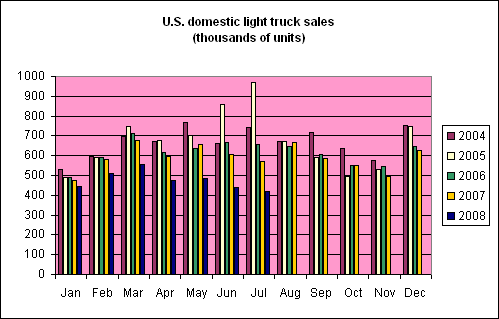 |
Domestic car sales are down 6.4% from last year, and again July of 2007 was unrepresentatively weak.
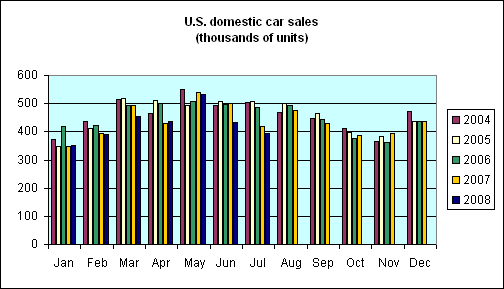 |
Sales of imports are doing much better.
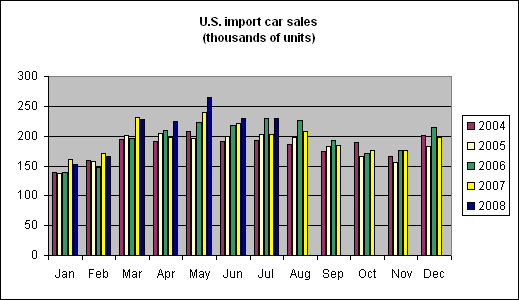 |
This is very much the pattern we observed in previous oil price shocks, with an abrupt drop in the demand for Detroit’s money makers and shift into more gas-stingy imports. The resultant hit to incomes in the auto sector is one of the mechanisms whereby an oil price increase can contribute to an overall U.S. recession.
It’s interesting to compare what we’ve observed so far this year with what happened during the oil price shock and economic recession that followed Iraq’s invasion of Kuwait in August 1990. With the loss of oil production from both Iraq and Kuwait, the price of oil shot up quickly, nearly doubling between July and October, after which it fell back down almost as dramatically. By contrast, the oil shock of 2008 has been a more gradual affair, caused by booming demand from China confronting stagnating global production. Although the price increases occurred more gradually, in percentage terms the cumulative change in oil prices over the last year is almost as big as we observed in the fall of 1990.
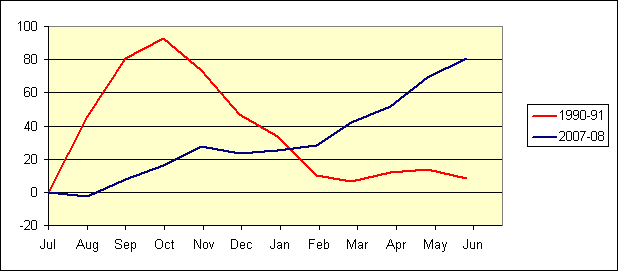 |
In terms of the consequences for auto sector employment, the number of U.S. workers employed in motor vehicles and parts fell by 62,000 workers in the month of November 1990, with a cumulative loss of 94,000 auto jobs before the recovery began in April 1991. By comparison, auto employment this past year fell by 83,000 workers, cumulatively about the same size disruption as in 1990, but spread out over a longer period.
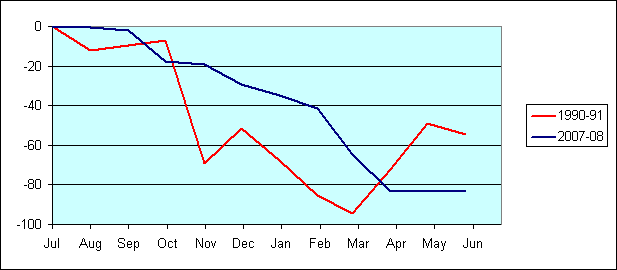 |
In terms of the effect on GDP, the contribution of motor vehicles and parts to real GDP fell by $15 billion between 1990:Q3 and 1990:Q4 and an additional $15 billion between 1990:Q4 and 1991:Q1. That corresponds to about 0.2% of GDP each quarter, or a hit to the annual growth rate of real GDP of about 0.8% each quarter.
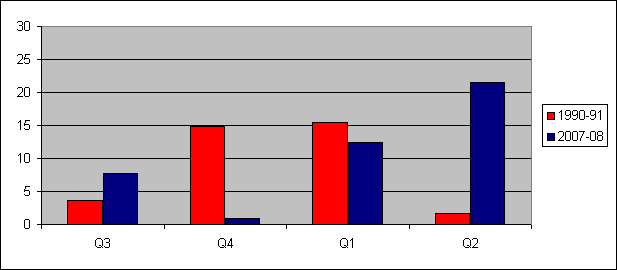 |
Again, the overall magnitude of the response we’ve seen in autos this year is comparable to that in 1990-91, with the sector subtracting $12 billion (in 2000 dollars) from 2008:Q1 real GDP and an additional $22 billion from 2008:Q2. But because the economy overall is larger than it was in 1990, that -$22 billion lopped off only 0.6 percentage points from the annual GDP growth rate for last quarter. In other words, if real production from this sector had been the same in 2008:Q2 as it was in 2008:Q1, and none of the other components of GDP were changed as a result, the growth rate for 2008:Q2 would have been +2.5% rather than the reported +1.9%.
 |
Of course, autos are not the only sector where we see significant shifts in spending as a result of a sharp increase in the price of oil. Airlines and some tourist-dependent areas are also hit hard, and there is an interaction between oil prices and the credit crunch for outlying exurban communities. Even so, the oil price increase in 1990 was not enough by itself to cause the recession, but may have been the factor that tipped an otherwise wobbly economy into freefall.
As Yogi Bera might say, looks like deja vu all over again.
Technorati Tags: macroeconomics,
autos,
auto+sales,
gasoline demand,
economics,
recession,
gas prices,
oil shock
This paper shows that high gasoline prices have a major effect upon sales of food away from home and grocery purchases:
http://papers.ssrn.com/sol3/papers.cfm?abstract_id=1032867
Are there any other ways in which high gasoline prices affect retail besides the auto, airline, tourism and food sectors?
Yes indeed, Charlie. To the extent that consumers reduce the number of gallons purchased by less in percentage terms than the price per gallon increased, total expenditures on gasoline increase so total expenditures elsewhere must fall. There would be a broad effect through this mechanism on all categories of consumer spending. In addition, there seems to be a negative effect on consumer sentiment, which would also be expected to show up in broad declines in spending.
An effective way to show this is a line chart showing the share of nominal consumer spending going to autos and to energy since about 1970. It clearly shows how increases in energy spending are offset and/or accompanied by cuts in auto spending.
Please. It was the credit crunch that has derailed the auto market. Gas Prices have not risen that much since mid-2006 over a longer period. It is the canary in the coalmine. Now that credit lines are being cut to the plastic, another leg down will begin as the inventory glut globally is worked off(global recession) through early 09.
Lower gas prices means less cars will sell. Yawn.
Sandman,
an “expected” global recession is a good thing these days, because it seems to be the only way (a really tough way) to level off raw materials costs all over the world!
So, financial investors must think that global demand is set to stagnate.
At least this appears what the industrialized Central Banks strongly desire, in order to bring consumer prices under control.
I think Sandman has a better theory. How could it be analyzed with data?
Maybe a chart of consumer spending on autos versus net increase in personal debt? Or even versus net increase in mortgage debt.
I believe such a chart would show brisk business while DTI is increasing followed by slow periods when debt is being worked off.
That correlation should be stronger than the one to oil prices.
Why have oil prices fallen lately (by ~15%)? Conventional wisdom says that speculation hasn’t been driving pricing. Does that comport with these recent changes?
Sandman, and your theory for why car imports have held up while domestic SUVs have plunged is…?
Larry, we talked about that issue here.
Lots of good discussion there. It leaves me with a few factors pushing oil prices downward of late:
Non-speculational:
– USD has strengthened some
– China has cut demand to prepare for the Olympics (since it’s 1-time, not sure if it’s a big deal)
– US demand continues down
Speculational:
– US auto demand crash (truck sales off >50% from ’05 high)
– New discoveries (Brazil offshore, Arctic)
– Bush’s elimination of executive order on offshore drilling
– Face2face negotiations with Iran
That about cover it?
Larry, I’m not sure I buy your distinction between “speculational” and “nonspeculational”. In any case, I think you’ve left out the most important factor, which is weakening European economy.
Thanks for the addition.
My distinction is a grope, trying to sift current changes in final demand (and currency, which I suppose is speculative, but not speculative about oil per se) from changes that derive from influences on future demand and supply.
I really don’t think that you can blame the domestic automakers’ troubles on the credit crunch than on cars that really really suck at $4 a gallon.
That said, however, the imports have been much less reliant on massive incentives and using their financing arms as their sole float. The most recent debacle, where GMAC had to take a $2 billion loss (half of which passed on to their half-owner GM) because they were taking possession of a bunch of worthless trucks and SUVs when the leases expired is just an example of that.
One might ask why consumers bought trucks and large SUVs after the 1990-91 price anomaly. Could it be that consumers actually prefer larger, more comfortable, safer vehicles and must be coerced into buying smaller cars [which Ford, GM, and Chrysler couldn’t give away but now can’t make enough]?
One might ask why Congress failed to increase the domestic availability of oil after the 1990-91 anomaly. Could it be that Congress felt that it might take until 2000 until the supply increase made any difference? One might also ask why Congress doesn’t simply accept vehicles that meet EU standards. Is there a problem with a small Ford car that has a European turbo-diesel that gets 55 mpg? Maybe it’s because Congress didn’t want to allow expansion of refineries to produce more diesel fuel… and that has increased the cost of nearly everything that requires distribution by trucks.
It is convenient to blame U.S. manufacturers for responding to a marketplace that valued larger vehicles. Of course, no one discusses the Toyota Tundra and Highlander or the Nissan Titan and Nissan Armada… their attempts at getting a share of what was a lucrative market.
It’s tough to run a business in a free marketplace… especially when the government has its hand in manipulating that marketplace.
As soon as we get electrics and/or biofuels working – and we will – we’ll be buying SUV’s and trucks again, in larger numbers than ever. We love those bad boys…
Larry,
You bring up excellent points.
Electrics: no new nuclear power plants to replace the coal-fire plants that Congress would like to shut down; ergo… what happens to millions of “plug-ins?” Congress also rejected requests to guarantee loans to build new U.S. battery plants; ergo… we must import batteries from Asia, but Toyota already must scale back hybrid production due to lack of batteries.
Biofuels: nice theory, but not a snowball’s chance in hell of seeing mass production.
How about hydrogen fueled vehicles based on natural gas? Ooops, can’t do that without expanding natural gas production which Congress is holding off limits.
How about compressed air? Just fill the tires to 300 psi and coast for free. Sure.
JDH,
in the regard of “the weakening European economy”, I would add a specific phenomena which is the cooling of the rocky German industrial cycle, along with an incoming deterioration of domestic demand across the whole euro area;
ooops… I almost forgot… also the seemingly recession dynamics of Japan.
Part of the problem, it seems to me, goes back some years to the inability of U.S. auto producers to make a profit in the market for cars, so they lobbied hard to keep ‘light trucks’ out of the mileage standards and started an arms war on U.S. highways with the SUV craze. But they were forced further into this corner by an undervalued yen in recent years.
Now, they are paying a price for their move to SUV’s, but part of their problem is still the undervalued yen.
Europe (via appreciation of the euro) is taking its share in the slowdown in global demand, but Asian economies (via pegged rates – explicitly for China and implicitly for Japan) so far are not.
JDH,
The price of oil has been rising for a lot longer than one year. Why compare only 2007-8 to 1990-1. Domestic auto makers have been bleeding badly for a number of years not just 2007-8. I would think that you would want to begin the current era when the inflation began, around 2002-3.
Also there was virtually no inflation in 1990-1, if anything perhaps a slight deflation. It would appear that the 1990-1 period was all global events and speculation while the current change appears to be a combination of demand and inflation. If that is true then while 1990-1 fell back quickly, 2007-8 would seem more likely to hold, for a while anyway.
To a point it almost seems like an apples and oranges comparison.
Good points DickF. If the 1990-91 price increase was a temporary shock to a system that was probably relatively close to equilibrium then little change in long run demand was to be expected. The current price of oil make more sense if one assumes that oil was underpriced for some time and the recent peak prices represent a temporary over-reaction to a long run real price increase trend. Since Autos and Trucks are to varying extents investment goods, cyclical behavior is to be expected. Back in the 1950s and 1960s forecasts in auto production were a major driver of GDP forecasts.
DickF, as I said on July 29,
See my further discussion from June 5.
@Bruce: “Electrics” – Of course we need nukes, but we’ll get them, and we’ll also get solar.
“battery plants” – Batter technology is finally getting interesting. We need a couple more generations of improvement before they’re ready for prime time, but industry has been improving power density steadily and some of the new stuff from places like Stanford looks pretty amazing. Once the economics are in place the factories will come. If Dem tax policies come into place I doubt anyone will build them here.
“Biofuels” – Why so glum? 100x drives investment and scale.
“Compressed air” – That one’s going to haunt Obama for months to come. “Inflate your tires now” reminds me of Ford’s WIN buttons! Did you see the thing out of MIT this week about electrolyzing water at 100% efficiency? That looks a lot more practical to my eyes (not now, but soon.)